Indoor flower campanula: care and reproduction
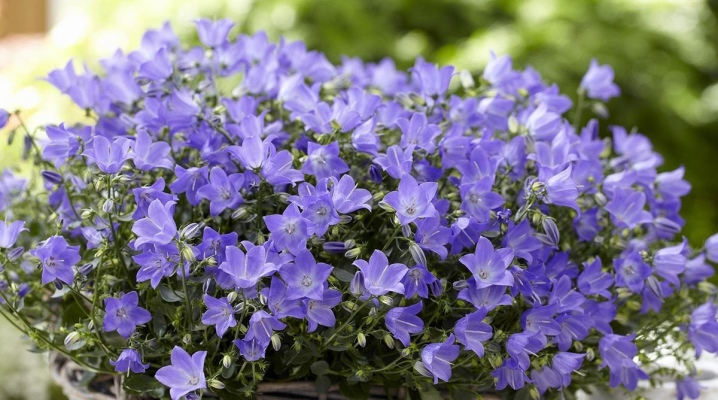
Among all indoor plants, bright campanulas take pride of place. These flowers are distinguished by a wide variety of tones and are actively grown both at home and in the open field. In this material, you will get acquainted with the peculiarities of caring for campanula, as well as with the intricacies of the reproduction of this indoor flower.
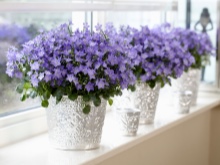

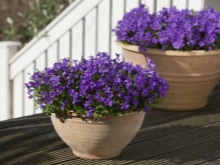
Description of the plant
Campanula belongs to houseplants from the Kolokolchikov family. For the first time, these plants were discovered in the Mediterranean, but very soon, thanks to their bright buds, similar to large bells, they spread throughout the world.
Today, campanula is considered a kind of symbol of joy and family happiness. That is why these flowers are usually grown in the homes of young couples.
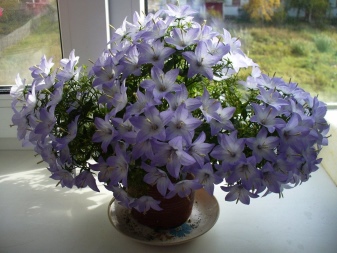
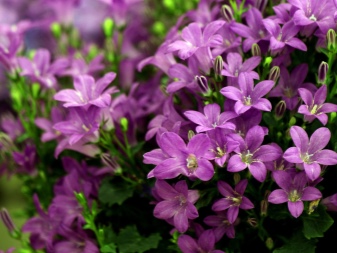
Depending on the variety, Campanula can have velvet or bell-shaped buds of a variety of colors - from pure white to deep purple. Some varieties are actively used in the decoration of the landscape design of gardens, where they create bright and rich accents against the background of other flowers.
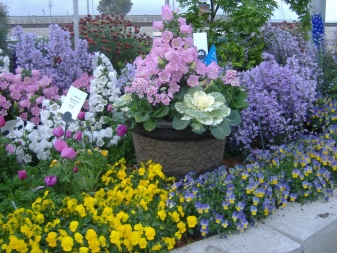
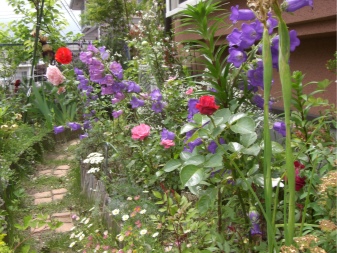

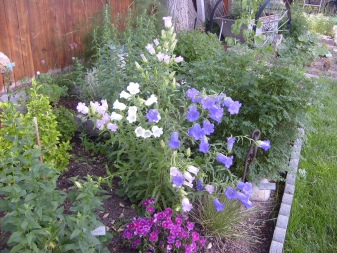
Varieties
Campanula combines several varieties at once, which include many varieties and hybrids. The most common types of this flowering plant.
- Campanula isophylla or isophyllous. Differs in a large height of shoots (up to 30 cm), round leaf plates with serrated edges, as well as voluminous flowers up to 4 cm in diameter. It was from this variety that two well-known hybrids - Alba and Mayi - the so-called "bride and groom" emerged.

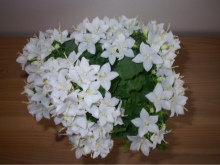

- Campanula Carpathian. Also a tall variety - up to 30 cm, but with ovoid leaf plates. Differs in large lilac or blue buds up to 4 cm in diameter.
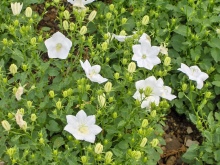
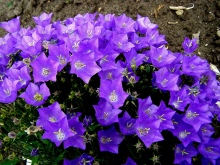
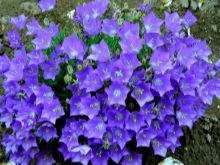
- Campanula Blauranca. Relatively small plant up to 20 cm in height. The buds are medium in size and delicate blue in color.
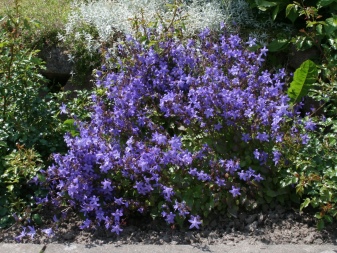
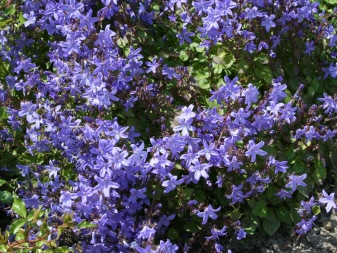
- Campanula Pozharsky. Not a particularly popular variety, which has long creeping shoots and small buds up to 2.5 cm in diameter. Their color is deep purple.

- Campanula gargana. A low, creeping plant with large, sky-colored flowers up to 5 cm in diameter. The flowering period is in autumn, the plant is shade-loving.
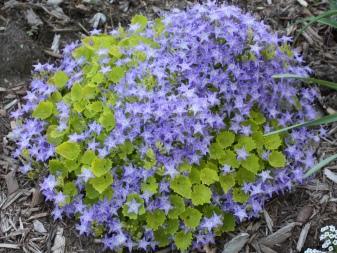
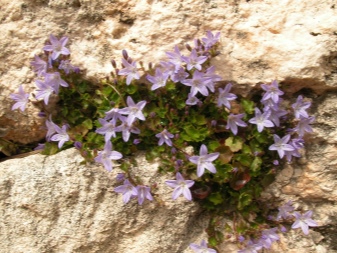
- Alpine Campanula. One of the shortest species with a height of up to 10 cm. It has a long flowering period with small buds of rich blue color.
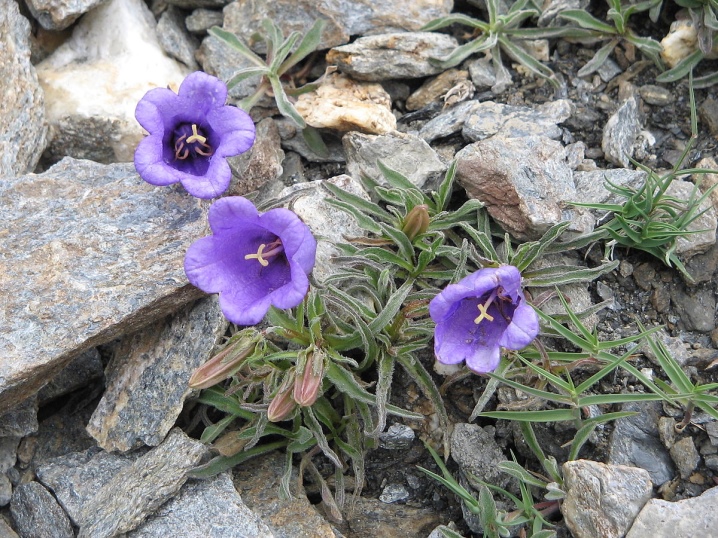
- Campanula spoon-fed. A plant with an average height of shoots up to 20 cm and small leaves up to 5 cm in length. The color of the buds, depending on the flowering period, can change from white to cobalt.


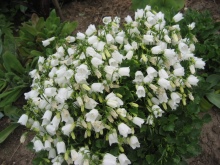
- Terry campanula. This home flower is a mix of Carpathian and spoon-leaved campanula. This species includes many decorative hybrids, each of which does not tolerate illiterate care. A distinctive feature of the flower is double buds of different shades on one bush.
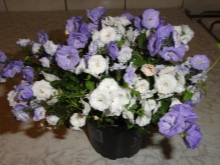
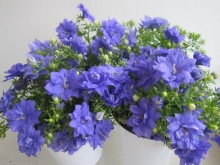
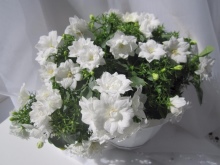
Conditions of detention
Growers know that keeping indoor houseplants takes a lot more time and effort than growing horticultural crops.
Unfortunately, domestic flowers have less strong immunity, most often they react poorly to frost, drafts and regularly need additional feeding.
Campanula, like other house flowers, needs no less attention.
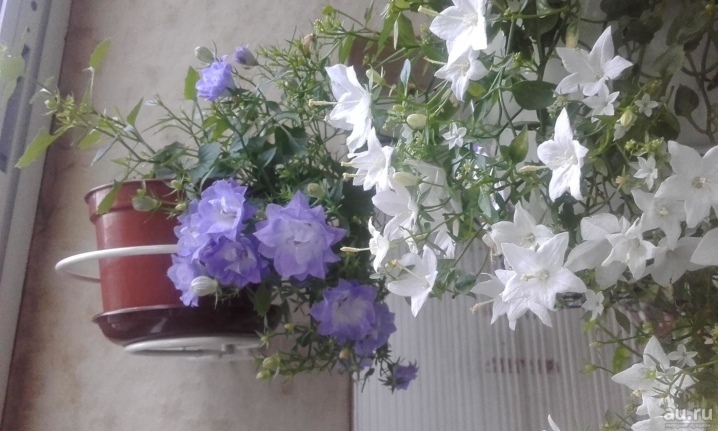
Lighting
For abundant flowering, campanula simply need abundant lighting, the sun's rays have a positive effect on the appearance of the leaf plates of the plant. In the case of keeping or growing this house plant, you need to maintain a stable level of natural and bright lighting, but do not allow direct sunlight to hit the flower.
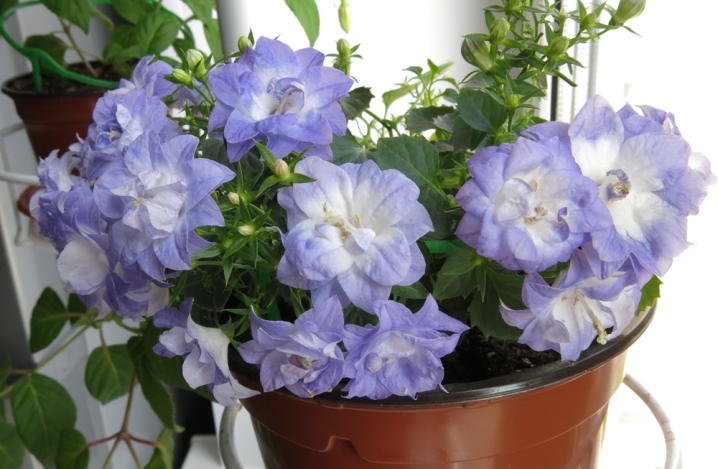
Temperature and humidity
In order for the campanula to look healthy and attractive, a special temperature regime and a certain level of humidity must be observed during its cultivation.
So, during active vegetation and flowering, a stable temperature of 24-27 degrees must be observed in the room, while in the place where the plant is kept, there should be no drafts.
During the rest period, the plant can be kept both indoors and on the balcony, however, the temperature in the room should not fall below 12-15 degrees.
Despite its good resistance to drought, campanula does not tolerate extreme heat, therefore, in addition to observing temperature standards, a stable humidity level of 40-50% must be observed.
Such indicators can be achieved through regular spraying of the plant or by installing containers with cool water right next to the pot with campanula.
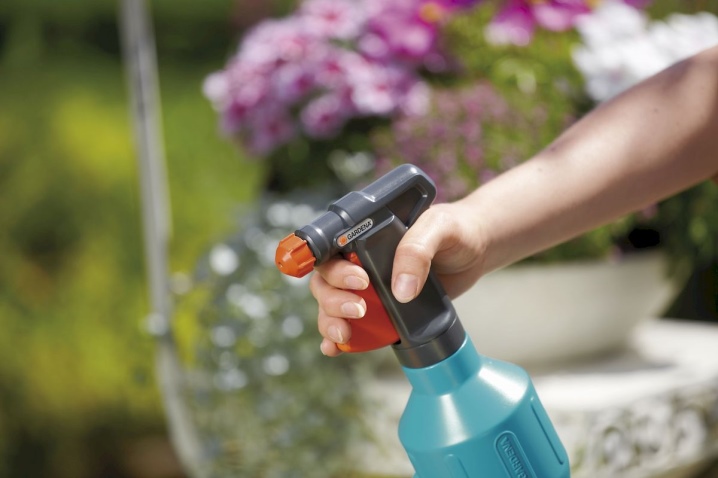
Pot and soil
Campanula does not apply to indoor plants, which can only grow in containers of a specific shape or from a strictly defined material. It will look great both in oval wooden pots and in plastic cups. Especially popular today are bowl-shaped and hanging pots made of plastic and clay.

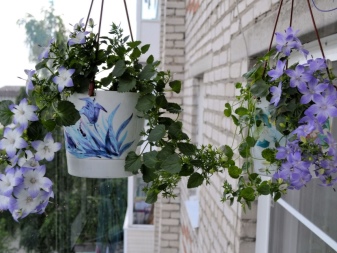
Consider that this flower has an extremely developed root system, which grows over time and can fill all the free space in the pot... When choosing a container for growing campanula, it is better to focus on whether a particular pot model will fit into the style of your room. Also, select containers with holes to drain moisture away.
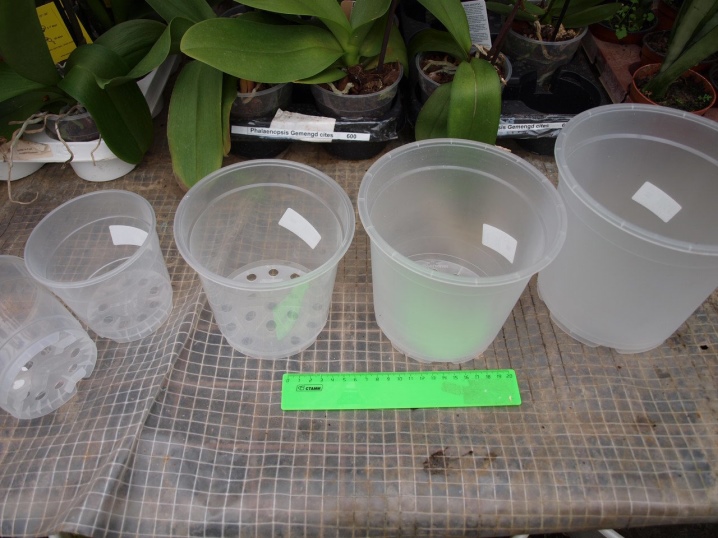
The composition of the soil also plays an important role in the cultivation of this flower. Light and loose soil with a lot of nutrients is best suited for campanula. You can buy it at any gardening store - it is considered a classic for all indoor plants, as it perfectly conducts air and water, which is important for any culture.
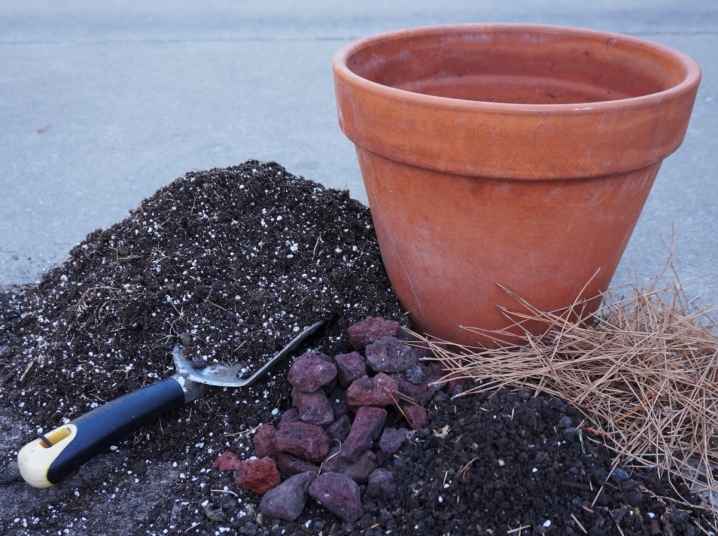
Planting and transplanting
A campanula transplant when growing at home is usually not carried out. This is due to the fact that such plants retain abundant flowering only for the first 3 years, and then it is much easier to grow new flowers by cuttings than to try to care for an old plant.
In some cases, transplanting is mandatory - for example, when dividing a bush, plant disease, or after buying a flower from a gardening store.
Experienced growers advise replanting Campanula in early summer or early October (before or after flowering). If the plant is purchased in a store, then it is better to transplant to a new place no later than 3 days after purchase.
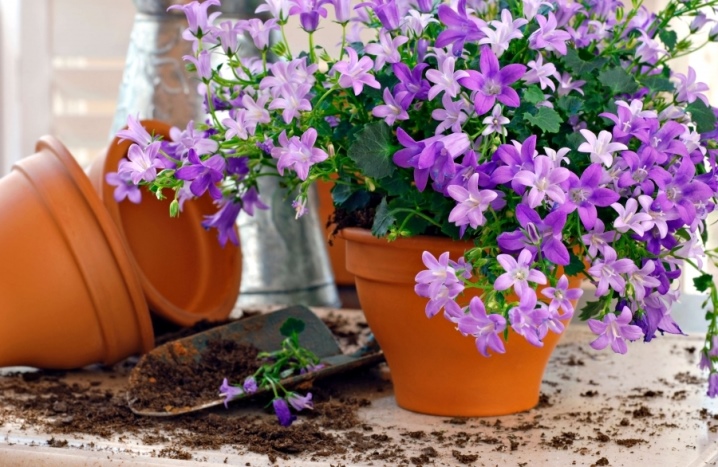
The transplant process itself looks like this.
- The pot or container for transplanting by ¼ is filled with a drainage layer in the form of gravel, expanded clay or broken brick.
- Drainage should be closed 1/3 of the mixture of purchased soil, or make it yourself from equal parts of sand and peat.
- In order not to damage the roots of the plant during transplanting, use the so-called transfer method - transplant the flower together with the mother's earthy clod into another pot. Before this, the campanula should be well watered.
- All the holes formed between the mother's lump and the new container are filled with fresh substrate. In the near-trunk circle, the soil is compacted and watered again.
- Ideally, the plant should be placed in a cool place under partial shade conditions. After it takes root and gets stronger, it should be returned to its permanent place.
- To achieve rapid growth of new shoots, it is recommended to carry out anti-aging plant pruning from time to time.
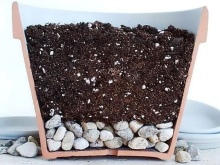
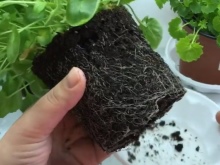
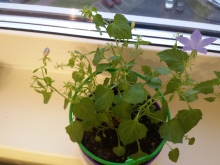
How to take care of it properly?
In order for any houseplant to look beautiful and attract attention, it should be regularly and carefully looked after. Campanula can hardly be called a finicky flower when it comes to leaving, however, some points are still worth paying attention to.
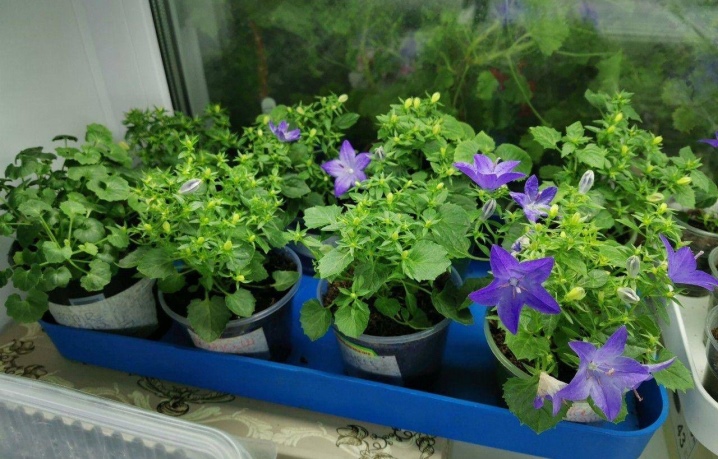
Watering
Campanula belongs to indoor plants that can do without moisture for a long time. In some cases, the bell can go without watering for up to 2 weeks, which is an indicator of the hardiness of some succulents.
Unfortunately, even despite such resistance to drought, Campanula is not able to maintain its beautiful appearance in the absence of moisture. That is why the owner of the flower needs to ensure that the soil in the pot in the summer always remains slightly moistened.
Particular attention should be paid to flowers that grow from the sunny and southern side of the apartment - they need regular watering.
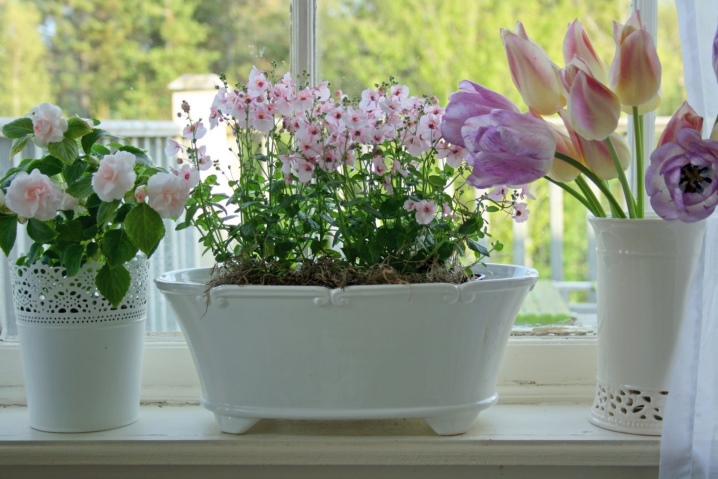
In the autumn and spring seasons, watering the campanula is advised to be reduced to several times a month, however, it is also not necessary to allow the soil in a flower pot to completely dry out. In winter, watering should also be carried out as the soil dries up, especially for flowers growing in well-heated rooms.
Watering can be carried out both under the roots themselves, and with the help of a sprayer. The latter should not be used in the summer season and during the flowering period - moisture on the flowers can provoke rot or sunburn.

In no case should moisture stagnation in the pot at the campanula be allowed. Any water that has passed through the holes in the pot and the drainage layer should be removed immediately. In case of stagnation of moisture in the roots of the plant, the chance of rotting of the root system increases. So that moisture does not linger at the root collar of the flower, the soil must be thoroughly loosened before watering.
For watering, it is best to use settled soft tap water or rainwater.
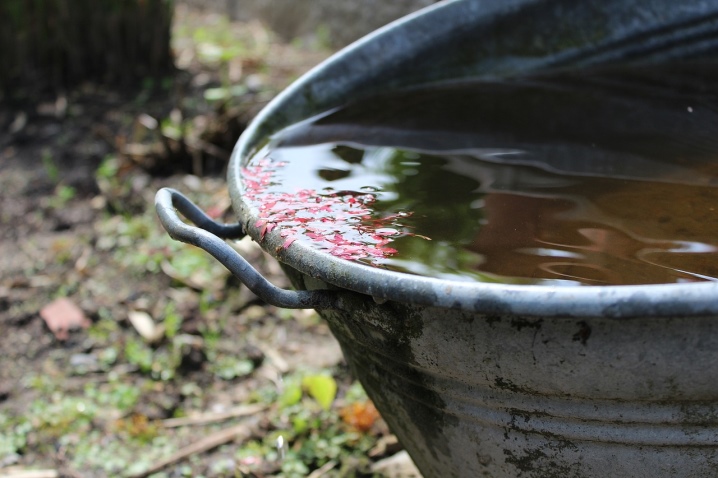
Top dressing
The need for additional feeding and fertilizers in campanula is manifested during the growing season and active growth. During this period, classical fertilizers for indoor plants with flowers should be added to the soil to the plant at least once every 2 weeks. In addition, the long and continuous flowering period, which can last up to several months, greatly weakens the plant and takes away all the nutrients from the soil.
To fertilize campanula, classic vitamin complexes for home plants can be used. Best suited drugs "Rainbow", "Pocon", "Bona Forte", "Agricola".

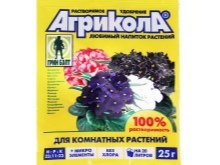

Do not forget to read the instructions for using certain complex fertilizers for indoor plants.
Avoid feeding campanula in late fall or winter - at this time, a dormant period begins, when the plant will accumulate strength for flowering next year.
Bush formation
To maintain a pleasant and healthy campanula appearance, flower owners often resort to decorative pruning. Usually this procedure involves removing wilted buds and dry leaves, but may involve a process such as pinching. It involves the spring removal of the upper 2-3 leaves from the shoots of the plant, after about a month the same procedure is carried out with the side leaves.
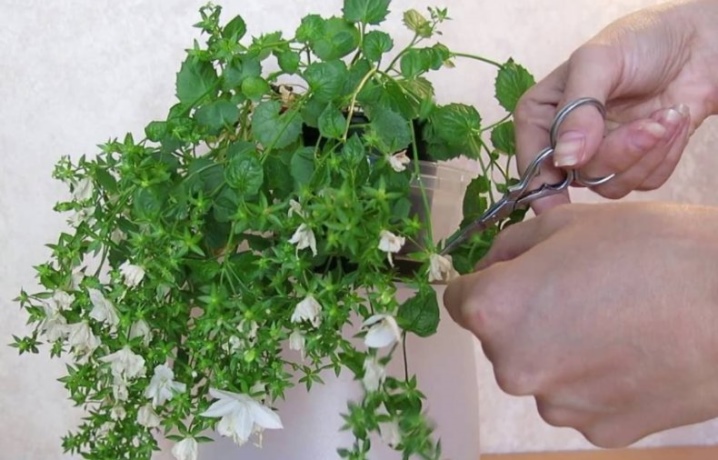
Dormant period
In late spring and winter, that is, during the dormant period of campanula, the plant should be placed in a cool room with good natural light, and the amount of watering should be reduced to 3 times a month. The best place for this would be a glazed balcony or loggia.
When preparing the campanula for the dormant period, all shoots of the plant must be shortened to a length of 12 cm. It will also be useful to cut off all dry leaves from the plant and remove the fallen leaves from the pot - it is dry leaves that often become sources of pest or fungus infection.
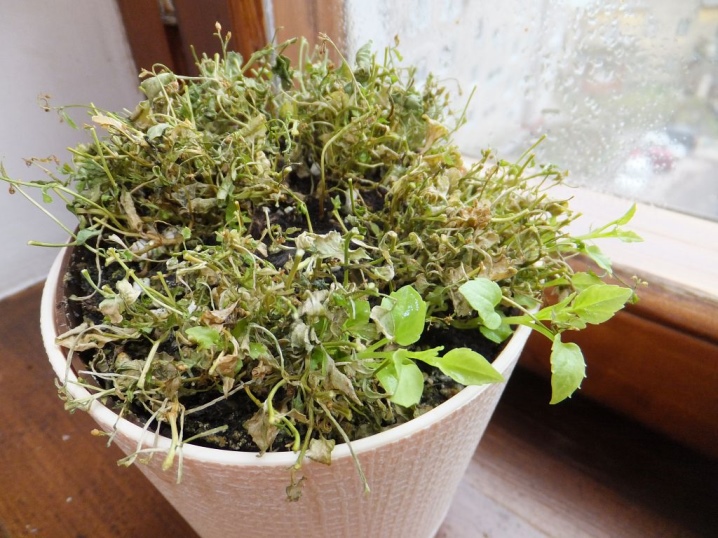
How can you multiply?
Some gardeners prefer to propagate Campanula on their own, rather than buying ready-made young plants that were grown in unknown conditions. For propagation of campanula, 3 methods are usually used: cuttings, dividing a bush or growing from seeds.
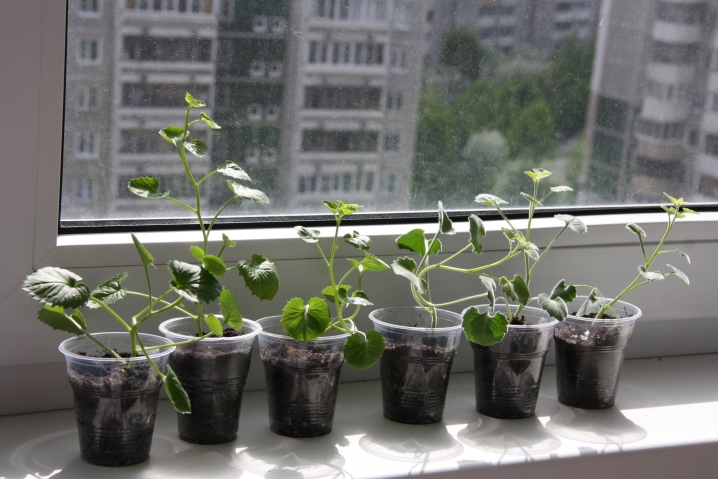
Cuttings
Usually cuttings are carried out in October - November. The cuttings themselves can be easily obtained with standard preventive pruning prior to dormancy.
- The safest and fastest way is to root the lower part of the shoot, which has its own full-fledged "heel" with young roots. In addition to its root system, such an shoot must have at least 3 full leaves.
- In order to stimulate the growth of the root system and help the cuttings quickly get used to a new place, its heel is placed in a container with a solution of potassium permanganate or "Fitosporin" for half an hour (5 ml per 1 liter of water will be enough).
- After that, the plant is placed in a container with water, where you also need to add one tablet of ordinary activated carbon (you can also add a little succinic acid).
- For planting campanula cuttings, wide and deep containers are prepared with a mixture of peat and sand in equal quantities. The cuttings are planted in the ground to a depth of no more than 3 cm, while maintaining a minimum distance between the shoots.
- To create a pleasant microclimate in the container, cover it with transparent film or glass, and ventilate it regularly. For the growth of healthy and strong roots, the temperature in the room should not drop below 24 degrees. Lighting should be bright, but not direct - therefore, cuttings do not need to be placed directly under the sun's rays.
- After about a month, after the cuttings have taken root, they should be planted in separate containers. As soon as the cuttings are accepted, and their shoots grow 7-10 cm, pinching can be carried out, which stimulates the growth of additional lateral shoots.


Dividing the bush
Experienced growers usually divide the bush during the campanula transplant. To propagate the plant in this way, you need to divide the herbal ball of the bell into shoots with their own root system. Unfortunately, Campanula has extremely dense and tangled roots that are usually difficult to untangle.
In this case, the entire root ball of the plant is divided into several equal parts using a sharp disinfected knife.
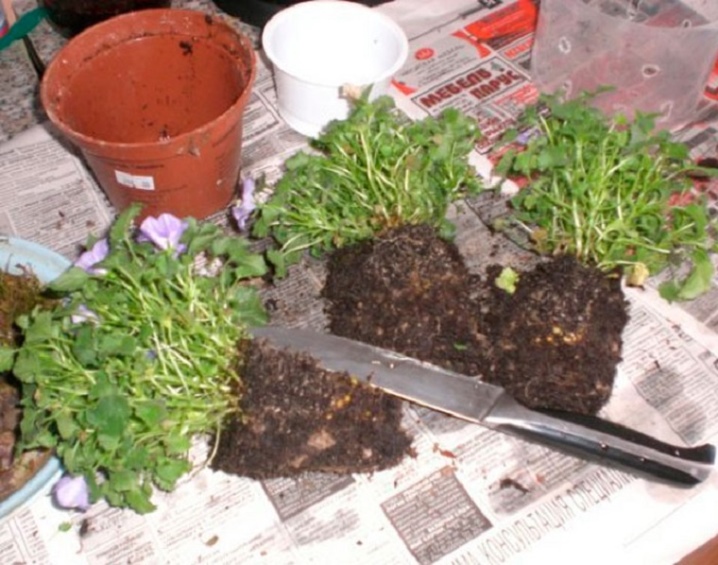
So that the cut parts of the roots do not rot and can take root in a new place, the cut points must be processed with crushed chalk or cinnamon. After this treatment, the separated plants are planted in separate pots, where they undergo standard care. To make it easier for the plant to get used to the new place, it should be watered immediately after planting, and a week after that, fertilized.
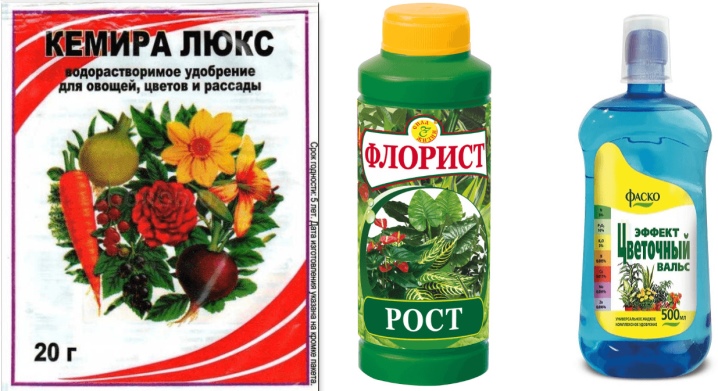
Seeds
Reproduction of campanula using seeds is considered the most unpopular, because it takes a lot of time and requires a lot of effort. It is recommended to collect the flower seeds themselves only after the flower box has dried, and then store them until planting in the next early spring.
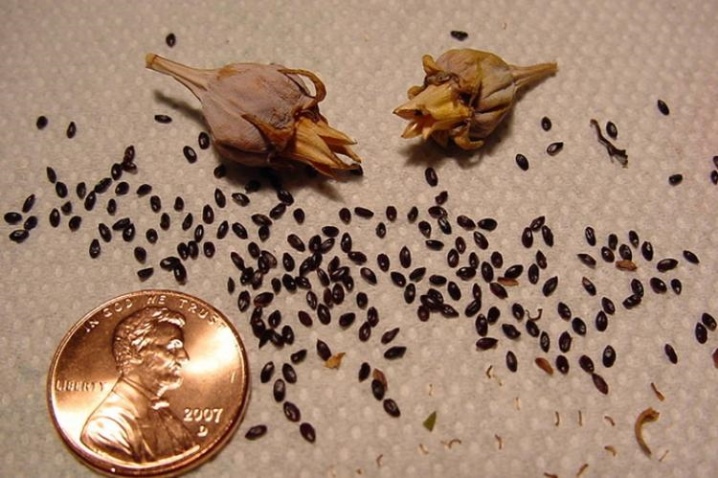
The process of growing bell seeds takes a very long time - up to 1 year. Its most basic stages should be considered in more detail.
- For planting seeds, flat polymer or wooden containers are usually chosen. It is better to use leafy soil or a mixture of sand and peat as a soil or substrate.
- The containers are filled with soil, after which the soil is leveled and thoroughly moistened.
- Campanula seeds are evenly distributed over the container and lightly sprinkled with sand on top, after which they are moistened again with a sprayer.
- In order to maintain a favorable microclimate in the containers, they are covered with foil or glass.Condensation, which will often form on the inside of the film, must be removed regularly. In addition, the containers should be ventilated.
- To stimulate plant growth, the soil can be sprayed with a rooting stimulant.
- The room where the containers with seeds are located should have a temperature of 22-24 degrees, as well as good natural light.
- If you did everything correctly, then the first sprouts of campanula will appear in a week. As soon as they have their own leaves (at least 3), a pick is carried out. Plants are planted in separate cups or pots, where they undergo standard care.

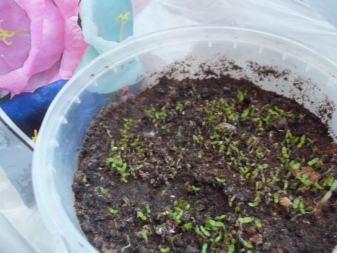
Diseases and pests
If an illiterate or irregular care is carried out for a campanula, if there is no regular watering or the temperature and humidity level constantly jump in a room with such a flower, the appearance of pests or diseases on it becomes only a matter of time.
The most common ailments and pests that campanula can suffer from, and methods for effectively dealing with them.
Root rot
Signs of this disease are the appearance of characteristic dark spots on the leaves of the flower, blackening of the stems of the plant, as well as the presence of mold in a pot with a substrate.
To cure the plant, it should be removed from the pot, all soil should be removed from the roots, the affected shoots and leaves should be cut off, and all cut points should be treated with activated carbon.
After that, the roots of the plant are placed for half an hour in a container with fungicides, then transplanted into a new pot with a layer of drainage and new soil.
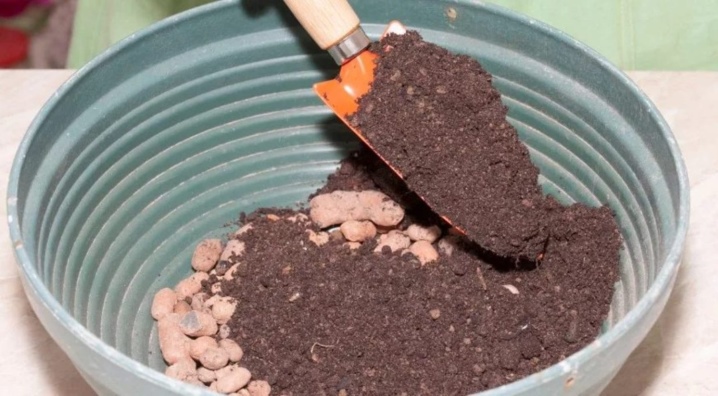
Gray rot
Among the most famous symptoms is the appearance of characteristic gray fungal spots with villi on the shoots or leaves of the flower. The treatment of the plant is identical to the treatment for root rot, however, in this case, the campanula should be watered with a solution of potassium permanganate once a week.
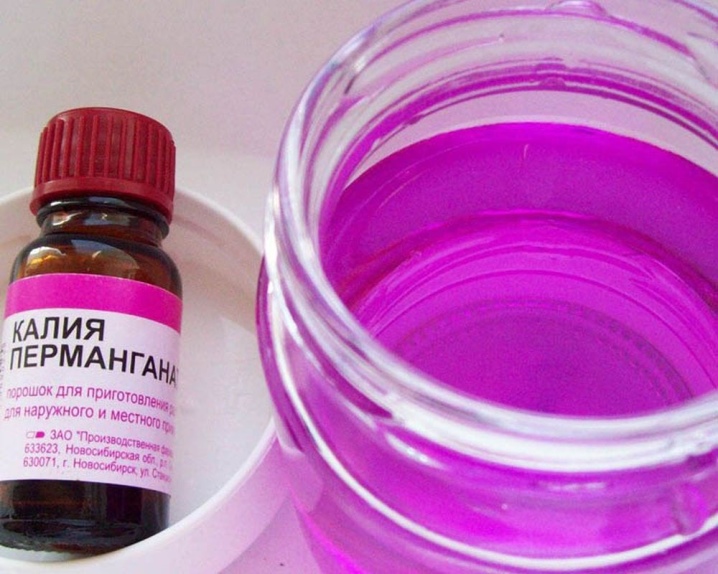
Pests
If the plant is grown indoors, then the risk of infection with some kind of parasite is minimal, but the eggs of some pests can get to the plant through untreated soil or garden tools. The most frequent "guests" of campanula are spider mites, scale insects and common aphids. Ticks can be identified by the presence of characteristic white cobwebs on shoots and leaf plates, scale insects look like small brown spots that adhere very tightly to leaves, aphids usually form whole colonies, and it is impossible not to notice it. In the fight against these pests, treatment with insecticidal preparations should help.
How to care for campanula, see below.































The comment was sent successfully.